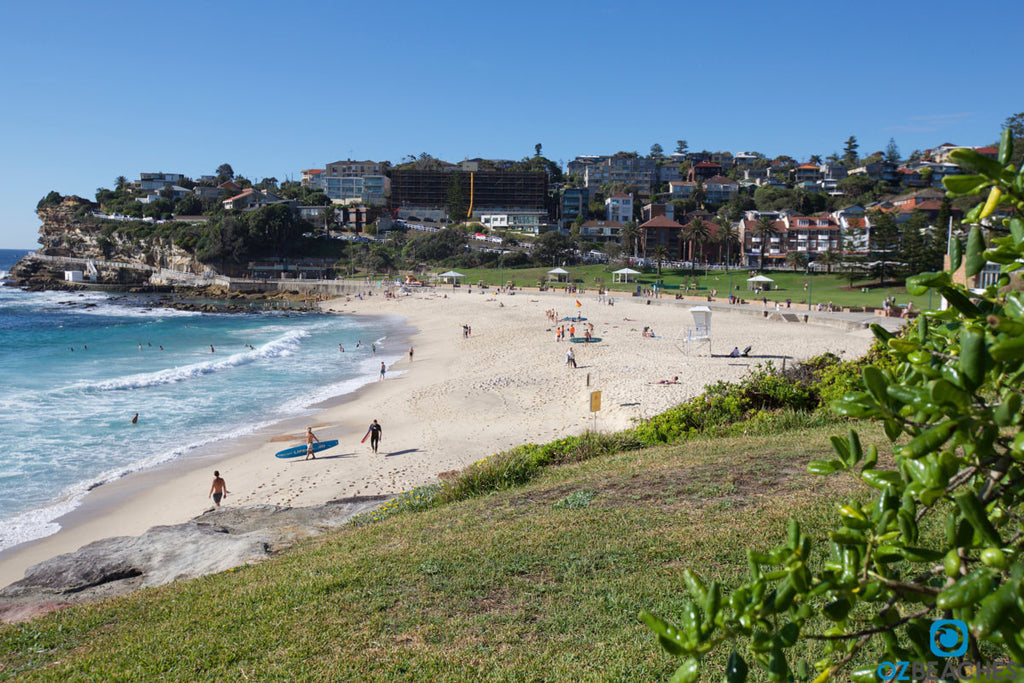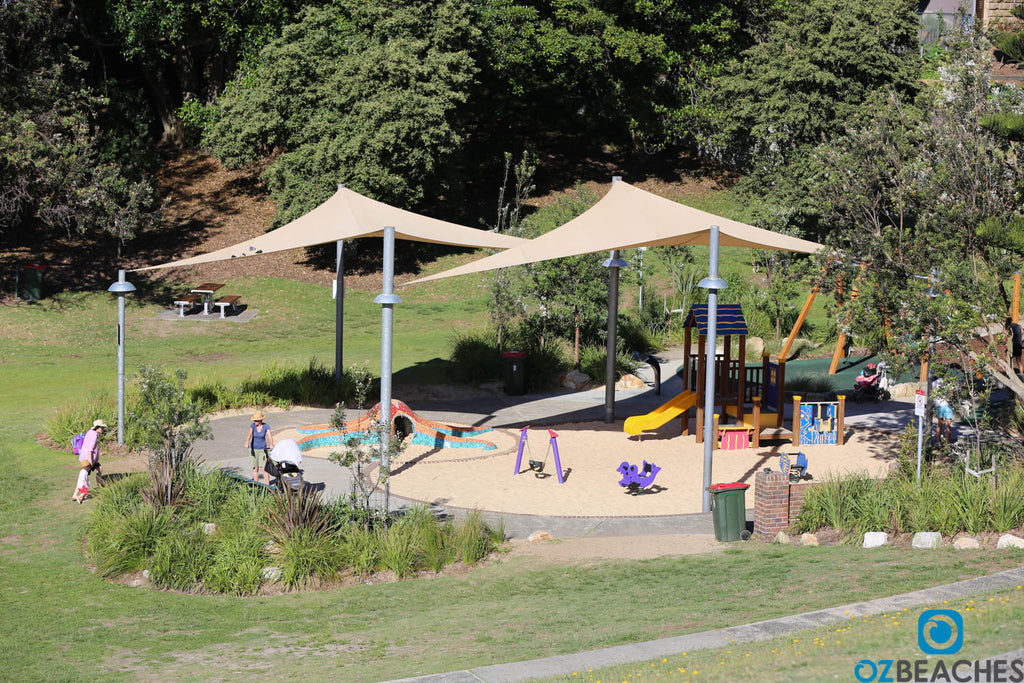
Bronte Beach showing off its many colours
Located around 10km from Sydney's CBD and 2km south of Bondi Beach, Bronte is one of the most popular and loved beaches in the entire eastern suburbs. While the beach is relatively small at around 250m in length, what Bronte lacks in size is certainly made up by the charm and character of its surroundings. The sand and rock-lined beach is set against a backdrop of steep cliffs, where multi-million dollar houses sit perched overlooking Bronte Park - a lovely 10ha valley covered with trees and expansive grasslands that sits behind the beach.

Bronte Tram circa 1959 - Image courtesy of Visit Sydney Australia
According to Wikipedia, the area around Bronte was originally owned by Mortimer Lewis in the 1830s, who was the Colonial Architect at the time. Mr Lewis sold his 42 acre holding of land to a man by the name of Robert Lowe (who later became Viscount Sherbrooke), who built his home in 1845 and named it Bronte House (this was in honour of Lord Nelson who was the Duke of Bronte in Sicily at the time). The heritage listed bungalow still stands today on what is now Bronte Road and is leased to private tenants by Waverley Council (open days are held a few times each year).

The kids tram runs weekends, public and school holidays until 4pm
It's hard to believe today, but there was once a time in the not too distant past where you could take a tram to Bronte Beach from either Bondi or Central in the CBD. If you've ever been to Bronte you'll realise that this must have been a feat of engineering for its day - the beach is located at the bottom of steep cliffs and sits in a valley surrounded by sandstone and trees, and the amount of work that must've gone into creating the line is mind-blowing. The line used to run from North Bondi to Bondi Junction, then headed down Bronte Road and into MacPherson Street and eventually to its end at Bronte Beach.

You can still see the tram cutting in the cliff, top left of the photo
The final approach, as it snaked perilously close to the cliffs edge down a steep bank overlooking the ocean, must have been awe inspiring, and this section is one of the more popular spots along the Bondi to Coogee Coastal Walk. The tram service to Bronte opened in 1911 and continued on for around 50 years until it was closed in 1960. The tram service was replaced by a bus service, and if you want to relive the journey simply jump on the 440 bus and let your mind wander back in time. Today there's a tram for children that runs on weekends and certain holidays which stands as a reminder to an era long forgotten.

View of Bronte Beach from the northern end
With great views, beautiful parklands, panoramic beach views and a bustling cafe scene, it's no surprise Bronte Beach is a popular place to stop along the Bondi to Coogee coastal walk.

Sea wall at the southern end of Bronte Beach
There's loads of facilities for the entire family including a playground for the kids, a wide grass and tree lined park behind the beach that sits in its own valley (providing excellent coverage from the sun), BBQs, picnic pavilions, rock pools, high cliffs and a beautiful rock-lined sandy beach. Not to mention the annual Sculptures By the Sea festival that draws crowds by the hundreds of thousands that descend on the area to admire the various sculptures by local and international artists.

Bring your kids here for a fun day at the beach

Get down to Bronte early if you want to grab one of these pavilions

A popular swimming place all year round
Bronte Beach is home to two beautiful rock pools that cater for all - a natural one that creates a sheltered lagoon and is popular with families, and another man-made ocean-fed lap pool that sits beneath the southern headland. Both provide a scenic swimming experience and are free of charge. An interesting feature of Bronte Beach is a large and naturally formed cave near the stairway at the northern end of the beach. If you want to explore it make sure the swells very small and the tide is low, as people have been known to get stuck in there and have to be rescued by the local SLSC.

The southern corner of the beach is protected in southerly winds
Bronte Beach is an east facing beach and picks up swell from nearly any direction, although solid ESE swells with light to strong NW-SW winds seem to produce the best surfing conditions. At the southern end of the beach near clusters of underwater rocks sits Bronte Reef, a fickle and sometimes fat wave during small swells that can transform into a heaving, powerful righthander that's been known to handle waves up to around 3m. There are a couple of sandbanks further up the beach that tend to produce lefthand waves, and due to constant rips (2-3 along the beach according to beachsafe.org.au) it is moderately hazardous to swimmers. The 'Bronte Express' is the name of the main rip and happily carries surfers and the unsuspecting out to sea near the southern headland.

With views like this it's easy to see why Bronte Beach is so popular
Bronte claims to be home to the oldest surf club in the world with patrols commencing in 1903, although the club was officially formed in 1907. The Bronte Splashers Winter Swimming Club also claims to be the oldest Winter Swimming club in the world being founded in 1921. This would make it older than the nearby Bondi Icebergs, which began in 1929.

Early morning sunrises light up Waverley Cemetery
Not too far from Bronte Beach and further south along the coastal walk is Waverley Cemetery, often referred to as Australia's most scenic cemetery. It is home to very well preserved Victorian and Edwardian monuments and it sits in a priceless and commanding position overlooking the Pacific Ocean. It officially opened in 1877 and has seen over 86,000 interments since then. Its most notable resident is none other than Henry Lawson (1867-1922), who is one of Australia's most famous poets to date.

Amazing colours against a backdrop of beautiful headstones
Catch the 440 bus from the Sydney CBD, the 378 bus from Bondi Junction, or the 362 bus from Bondi Beach direct. If driving you can enter via MacPherson Street or head down Bronte Road and follow the signs. Parking is very limited (especially in the summer months), and behind Bronte Park is probably the best option on a crowded sunny day.
Tamarama Beach is the next beach north from Bronte Beach
Clovelly Beach is the next beach south from Bronte Beach
I hope you enjoyed reading this article as much as I enjoyed writing it. Bronte Beach is a hive of activity all year round and is adored by both locals and visitors alike. Australia Day is especially busy down at the beach, with the picnic pavilions and wide grassy area proving hugely popular, as well as the high headlands providing excellent shelter from strong winds. Bronte Beach has long been a family favourite for a day at the beach, and this isn't going to change anytime soon as it truly has something for everyone. Do yourself a favour and get down there and immerse yourself in its history, beauty, and everything else it has to offer.
All photos in this article are available for purchase in various sizes as high resolution acrylic glass or canvas prints, and are available for licensing purposes for media and marketing/promotional material. The photos you see here have been compressed for optimal online user experience, which means we've intentionally reduced the file size and quality of each image to ensure the pages you visit load faster.
Any printed reproduction of the photos you see on OZBEACHES would be done using the original 20+ megabyte RAW files, with the additional layer of having a professional graphic designer personally inspect each image and optimise for print. The OZBEACHES watermark would be removed and would not be visible on your print. If you have any questions about this process, please email me (Adam) and let me know which photo you're interested in by quoting the caption beneath it. Alternatively you can check out our featured images in the print gallery.
If you think Bronte Beach is a place you'd like to visit with your friends, why not share this article with them via one of the social links below. I want to help people (including you!) find their dream Australian beach, and the more information we share together will ultimately help us all in achieving that goal. I hope you enjoy your search.
Cheers,
Adam